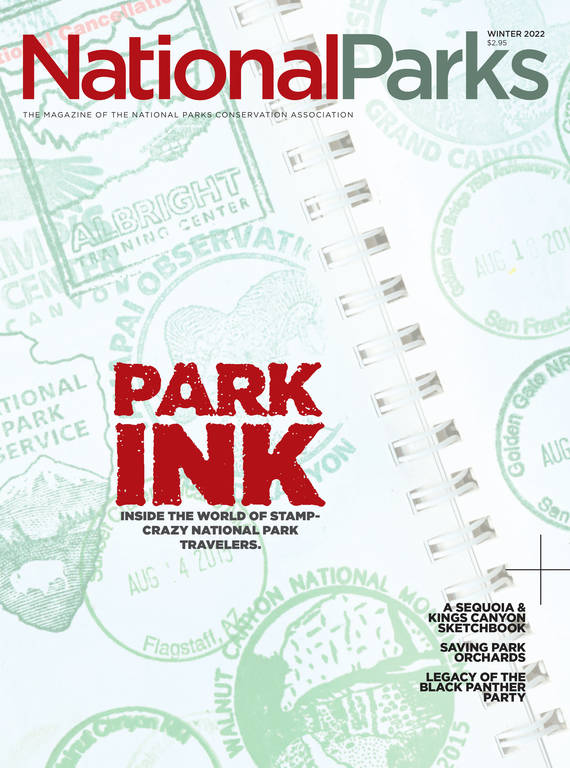Winter 2022
Finders Weepers
Every year, national parks receive dozens of rocks and artifacts returned by remorseful visitors. What are parks to do with the stuff?
In August 1988, a woman named Tracie typed and mailed a letter to the superintendent of Petrified Forest National Park in Arizona. Enclosed were pieces of petrified wood that she and her father had pilfered from the park’s Crystal Forest. After taking the rocks, Tracie wrote, they visited her sister in California, where her father was mauled by her sister’s cat. His injuries would send the family to the emergency room, but not before Tracie’s sister learned that she’d lost her job. The following morning, Tracie broke the toaster while warming some waffles. An ensuing family argument almost ended their visit altogether.
“We all decided to send these small pieces of nature back, before our bad luck streak escalated,” Tracie wrote. “PLEASE return them to their rightful place.”
It was just one of hundreds of such packages received by Petrified Forest and other national parks over the years, according to Gwenn Gallenstein, the museum curator for Flagstaff area national monuments. Gallenstein recently published an article about what she calls “remorseful returns” in the museum journal Collections. She first encountered the phenomenon in the early 1990s at the Museum of Northern Arizona, where people anonymously left artifacts outside the doors, and she later came across a box of returned objects and letters at Canyon de Chelly National Monument. The practice dates back at least to 1935, when a piece of fossilized wood was returned to Petrified Forest all the way from India. Potsherds are the most commonly returned items, but others range from the morbid — staff at a Utah park once discovered fragments of human skulls left in a box — to the banal. Grand Canyon National Park has received pinecones, twigs and old bottles scavenged from garbage dumps that some visitors thought might be historic. Other parks have had objects returned that staff identified as items purchased from a gift shop.
Only a portion of the returns come with a letter, but the letters reveal the many motivations people have for returning things. Some letters are penned by errant children at the behest of their parents. Others come from people who were cleaning out a family member’s attic and discovered the artifacts. Some letter writers cite a religious awakening for exposing their wrongdoing.
Many letters invoke the idea of bad luck or a curse falling upon the people who took the items. Lava rock is mailed back to Hawai’i Volcanoes National Park for fear of the Hawaiian goddess Pele. Ancestral Puebloan potsherds are returned to appease what some letter writers call “Indian spirits,” and bags of dirt are shipped back to Gettysburg National Military Park to lay Civil War ghosts to rest.
Removing artifacts and other objects from federal land is illegal and can lead to serious penalties. Under laws that include the Antiquities Act of 1906, the Native American Graves Protection and Repatriation Act of 1990, and the Paleontological Resources Preservation Act of 2009, people who steal or illegally trade fossils, artifacts or Native American remains can face thousands of dollars in fines and years in prison. At Petrified Forest, people caught removing rocks or other resources face a minimum $325 fine.
Still, the impulse to pocket treasures persists, and curators estimate that returned items account for only a fraction of what is taken. According to data extrapolated from a law enforcement experiment in the 1990s in which potsherds were deliberately left in piles near a trail, an average of one sherd per visitor walks out of Chaco Culture National Historical Park in New Mexico every year.
“If that’s an accurate data point, the loss to the park through the years is pretty astounding,” said Wendy Bustard, the park’s retired curator. “Sherds are not a renewable resource. Once they’re gone, they’re gone.”
Souvenir hunting can have a catastrophic impact. In 1957, South Dakota’s Fossil Cycad National Monument lost its status because so many people — including researchers — had walked off with the plant fossils that inspired the park’s designation in the first place.
While Gallenstein is glad these returns keep artifacts out of landfills, she said no park has a perfect solution for what to do with the stuff. Most items cannot be returned to the land without altering the natural and historical record. When appropriate, parks repatriate human remains to the relevant tribes, but when it comes to other items, curators, busy with their daily demands, are equally likely to put returns on a shelf and forget them.
“It’s a false hope to think you can return something to a national park and that anything is really going to happen to it,” Gallenstein said. “You might think, ‘I’ve done my good deed for the day.’ But you’ve just created somebody else’s problem.”
Curators at Chaco Culture inherited many of those problems. Since 1983, Chaco’s staff processed more archaeological returns than any other park in Gallenstein’s study — north of 6,000 potsherds. People sending those sherds likely imagined them being returned to the park’s grounds. But archaeology is an exacting science.
“Once the sherds are removed from their actual location, the amount of archaeological information drops almost to zero,” Bustard explained. “Because provenience has been lost on these items, you can’t just return the material to anywhere in the park.”
For each returned potsherd, Bustard recorded as much information as she could and then accessioned the items into the park’s collection. Occasionally, the sherds are used for scientific analysis or an educational exhibit, but most just sit in boxes.
By now Matt Smith, the curator at Petrified Forest, can recognize the returns before he opens the packages. They often come in boxes whose edges are battered by their angular and weighty contents. They trickle in throughout the year, but the pace quickens whenever the phenomenon appears in the news or on TV. (A large uptick followed the 2019 Netflix show “Dead to Me,” which featured a storyline about a curse following someone who stole fossilized wood from the park.)
While the park is certainly not about to run out of petrified wood, the amount returned since the 1930s could be measured in tons. And Smith faces the same problem as Bustard: He can’t replace the pieces without knowing their original locations. Doing so would hamper research into how this unique landscape came to be.

National Parks
You can read this and other stories about history, nature, culture, art, conservation, travel, science and more in National Parks magazine. Your tax-deductible membership donation of $25 or more entitles…
See more ›“We don’t want to throw bad evidence out there,” Smith said, “just like you wouldn’t want to contaminate a crime scene.”
Instead, the rocks are hauled out to an inglorious pickup-sized heap, known informally as the “conscience pile,” off a private service road in the park. The letters are temporarily stored in a banker’s box.
Smith relates to the urge to take mementos from a special place. As a child, he scoured the creek beds near his house in Florida for shark teeth and other fossils, a passion that propelled him to become a paleontologist. He didn’t know then that he needed a permit. Today, visible signage and vehicle checks compel Petrified Forest visitors not to take any rocks or other objects, but in this magical landscape, the temptations are great.
“There are hand-sized bits of loveliness that are just lying everywhere,” he said. “It’s remarkable and colorful, there’s a ton of variety, and it’s accessible.”
Still, Smith hopes people will reconsider their souvenir-taking. Stolen keepsakes make poor heirlooms. “You’re leaving a burden for the people who come after you, whether it’s your family or Park Service staff,” he said. “It’s a headache. But it’s a headache I understand, I guess.”




